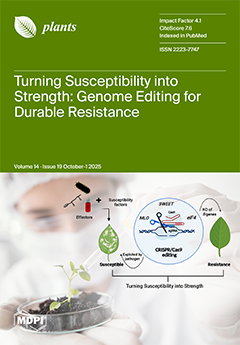Salt stress is a major abiotic factor limiting crop productivity worldwide, as it disrupts plant growth, metabolism, and survival. In this study, we report that the genes
PvPR10-2 and
PvPR10-3 were significantly up-regulated in bean leaves and stems in response to combined salt
[...] Read more.
Salt stress is a major abiotic factor limiting crop productivity worldwide, as it disrupts plant growth, metabolism, and survival. In this study, we report that the genes
PvPR10-2 and
PvPR10-3 were significantly up-regulated in bean leaves and stems in response to combined salt and jasmonic acid (NaCl–JA) treatment. Foliar application of JA with salt induced physiological alterations, including stem growth inhibition, H
2O
2 accumulation, and activation of antioxidant enzymes. To investigate the role of
PvPR10-3 in response to salt and phytohormones, we introduced this gene into
Arabidopsis and found that its heterologous expression conferred salt tolerance to the transgenic lines. Interestingly, exogenous JA contributed to salt tolerance by reducing H
2O
2 levels, inducing ROS-scavenging enzymes, and promoting the accumulation of phenolic compounds and ABA. Furthermore, gene expression analysis of the transgenic lines revealed that
PvPR10-3 expression under NaCl–JA stress is associated with the induction of JA-related genes like
MYC2,
JAZ2,
JAZ11, and
JAZ12, as well as SA-responsive genes, like
ALD1 and
TGA2, and two ABA-independent components
DREB2A and
ERD1, suggesting potential coordination between JA, ABA, and SA signaling in salt stress response. Additionally, key flowering regulators (
FT,
GI) were upregulated in transgenic lines under NaCl–JA treatment, suggesting a previously unexplored link between salt tolerance pathways and the regulation of flowering time. Taken together, our findings suggest a role of
PvPR10-3 in enhancing salt stress tolerance and the involvement of exogenous JA in tolerance potentially by modulating ROS balance, hormone-associated gene expression, and protective secondary metabolites.
Full article






